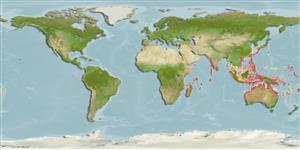>
Eupercaria/misc (Various families in series Eupercaria) >
Lethrinidae (Emperors or scavengers) > Lethrininae
Etymology: Lethrinus: Greek, lethrinia, a fish pertaining to genus Pagellus.
More on author: Valenciennes.
Environment: milieu / climate zone / depth range / distribution range
Ekologi
marina; brackvatten revassocierade; ej vandrande; djupintervall 5 - 25 m (Ref. 1602). Tropical; 35°N - 30°S
Indo-West Pacific: Indonesia (including eastern Indian Ocean side), northwestern Australia, Philippines, southern Japan, Papua New Guinea and the Caroline Islands. This species has long been recognized as Lethrinus nematacanthus and the name Lethrinus genivittatus misassociated with many other species.
Size / Vikt / Age
Maturity: Lm ? range ? - ? cm
Max length : 25.0 cm TL hane/ej könsbestämd; (Ref. 2295); common length : 15.0 cm TL hane/ej könsbestämd; (Ref. 2295); rapporterad maxålder: 7 år (Ref. 2290)
Taggstrålar i ryggfenan (totalt): 10; Mjukstrålar i ryggfenan (totalt): 9; Taggstrålar i analfenan 3; Mjukstrålar i analfenan: 8. The only Lethrinus with its 2nd dorsal spine the longest. The inner surface of the pectoral fin may be scaleless, partially covered with scales or densely covered with scales. Body color is tan or brown on the upper sides, white on the lower sides, with three tan or brown stripes. The sides often have scattered irregular black oblique bars and a square black blotch above the pectoral fin and bordering below the lateral line. The head is brown or tan sometimes with several broad, somewhat indistinct vertical and oblique bands (these bands are sometimes composed of fine reticulations). The fins are pale, speckled with small white blotches.
Solitary or in groups (Ref. 90102). Occurs over shallow sandy and seagrass beds, in mangrove swamps, lagoons, channels and outer reef slopes. May enter rivers. Feeds on crustaceans and small fishes. A protogynous hermaphrodite (Ref. 55367). A protracted spawning peak from July to December is recorded in New Caledonia. Smaller and more numerous females than males have been confirmed in Australian populations. Marketed fresh (Ref. 9775).
Life cycle and mating behavior
Könsmognad | Reproduktion | Lek | Ägg | Fecundity | Larver
A monandric species (Ref. 55367). Length at sex change = 18.0 cm TL (Ref. 55367). Also Ref. 103751.
Carpenter, K.E. and G.R. Allen, 1989. FAO Species Catalogue. Vol. 9. Emperor fishes and large-eye breams of the world (family Lethrinidae). An annotated and illustrated catalogue of lethrinid species known to date. FAO Fish. Synop. 125(9):118 p. Rome: FAO. (Ref. 2295)
IUCN Red List Status (Ref. 130435)
Threat to humans
Harmless
Human uses
Fiskeri: mindre kommeriell
Ytterligare information
referenserVattenbrukVattenbruksprofilAvelslinjerGenetikElectrophoresesÄrftlighetSjukdomarBehandlingNutrientsMass conversion
Verktyg
Special reports
Download XML
Internet-källor
Estimates based on models
Preferred temperature (Ref.
123201): 24.7 - 29.3, mean 28.4 °C (based on 2863 cells).
Phylogenetic diversity index (Ref.
82804): PD
50 = 0.5000 [Uniqueness, from 0.5 = low to 2.0 = high].
Bayesian length-weight: a=0.01349 (0.00868 - 0.02097), b=2.97 (2.85 - 3.09), in cm total length, based on LWR estimates for this species & Genus-body shape (Ref.
93245).
Trofisk nivå (Ref.
69278): 3.7 ±0.0 se; based on diet studies.
Generation time: 1.3 ( na - na) years. Estimated as median ln(3)/K based on 2
growth studies.
Resiliens (Ref.
120179): Mellan, lägsta populationsfördubblingstid 1,4-4,4 år (tmax=7; K=0.86).
Fishing Vulnerability (Ref.
59153): Low vulnerability (17 of 100).
Nutrients (Ref.
124155): Calcium = 78.8 [52.0, 133.1] mg/100g; Iron = 1.09 [0.68, 1.75] mg/100g; Protein = 20.5 [17.9, 22.8] %; Omega3 = 0.148 [0.096, 0.231] g/100g; Selenium = 33 [19, 62] μg/100g; VitaminA = 29.6 [6.0, 178.6] μg/100g; Zinc = 3.07 [2.21, 4.16] mg/100g (wet weight);
